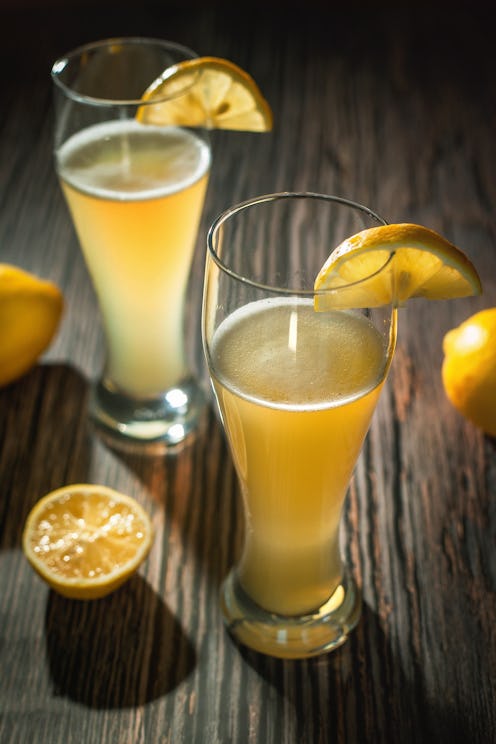(Entertaining)
Craft Beer Is Chicer Than Ever
Brewed brilliance.

Gone are the days of beer only being a modest beverage to serve at a tailgate party or college dorm gathering. Artisanal and craft brews have reshaped the industry to the point that beer enthusiasts are giving oenophiles a run for their money. While grabbing a traditional American six-pack is still an option for those who prefer nostalgia or simplicity, there’s an entire world of ultra-chic craft beers to be explored, from hops to Hefeweizen, with sophisticated flavors that refine and redefine the beer-drinking experience.
According to statistics by ResearchAndMarkets.com, the craft beer market will grow at a CAGR of 10.4% by 2028, to 52.47 billion dollars. Though these sophisticated suds are getting a lot of recent attention, the artisanal beer era has been on the brink of explosion for years, decades even. “The first push in craft brewing came in 1978 when home brewing was legalized,” says Joe Correia, head brewer and co-founder of Torch & Crown Brewing Company. “Brewers first began by imitating European and Old World style beers until the ‘90s when hops began to really grow in popularity in the US, leading to the American IPA.”
If you’re a beer novice and already confused, fret not. Aaron Baker, senior marketing manager for Oskar Blues Brewery has provided a bougie beer cheat sheet/glossary extraordinaire. Let’s review.
- West Coast Style IPA: Known for its bold, bitter, and hop-forward qualities.
- Hazy or East Coast IPA: Also hoppy, but not as bitter as the West Coast-style IPAs, it features a smooth mouthfeel with fruity characteristics as well as a cloudy appearance because it is not filtered during production.
- Imperial & Double IPA: These present an intense hop profile and a higher alcohol content.
- Pale Ale: Usually offers a nice balance between hop and malt with a flavor profile that can range from more to less bitter.
- Lager: The most popular beer style in the world. This is the style that mass-produced, ‘big beer’ breweries are built on. They offer a flavor that is often described as crisp, light, and refreshing. These days, more and more craft breweries are exploring this crowd-pleasing style, adding their own spin on the classic.
- Pilsner: A variation of a lager, it contains a bit more hop flavor.
- Stout: The beer is dark in color and typically offers deep flavors of chocolate, coffee, and even black cherry or dried fruit.
When it comes to the latest beer trends, Correia, says that people these days are often looking to the lighter side, meaning more delicate beer styles, which manifests as “revisiting Old World beer styles and modernizing them with the brewing techniques we’ve developed over the last 10 to 20 years.” He’s also seeing lager regain popularity in the US and brewers pushing the boundaries of IPAs even further, exploring “different flavors that exist in hops.”
Baker adds that breweries are also adding other beverages to their repertoire, hoping to find success with items like cider, flavored malt beverages, hard seltzers, and even spirits. He gives a nod to one trend sweeping every alcoholic beverage category, including beer: “[...] a trend toward lighter beers and non-alcoholic beers,” Baker says.
When it comes to beer in a bottle versus a can, neither expert hesitated with their opinion. The winner was unanimous: can. “Though bottles look nice and elegant, cans are far more shelf stable and do a much better job of protecting the beer's flavors so people can experience the taste the way the brewer intended them to,” Correia says.
“Back when Oskar Blues got its start, almost all breweries turned their noses up at craft beer in a can in favor of bottles,” Baker remembers. It was thought that the aluminum of the can would give the beer a metallic flavor. Modern-day aluminum cans are lined with a water-based coating, so the beer and the can never touch, Baker explains.
Rules Of Thumb
When faced with a multitude of craft beer choices at the store, it can make newer beer drinkers feel anxious to pull the trigger and try a new brew. Our experts are armed with tips to help you on your search.
Correia prioritizes a couple of factors when choosing a new beer. “First and foremost, I look at the freshness of the beer, paying attention to the canned-on date or packaging date which is usually on the bottom of the can or neck of the bottle,” he says. The fresher the beer, the more it embodies its intended flavors and characteristics. Supporting local breweries is another aspect he values, as proximity often translates to freshness.
Baker echoes the importance of freshness with this warning and recommendation: “Not all breweries package beer with the same eye towards quality. For canned or bottled beer, try to test out a small amount of a brewery’s packaged products first to get a sense of their quality.” Baker also suggests visiting a local brewery to sample different beer styles before hitting the store. “Even better if you can find a brewery with knowledgeable beer-tenders on staff,” he says. “Then you can take that knowledge to a local bottle shop or grocery store to explore similar beer styles from other breweries to find a favorite.”
Correia offers one last and crucial piece of advice to keep in mind, “Considering the alcohol content is essential. Depending on the occasion, opting for higher-ABV beers with more intense or lower-ABV options for sharing can enhance overall enjoyment.”
Ahead, expert-approved sophisticated suds that prove that beer is a humble brew no more.